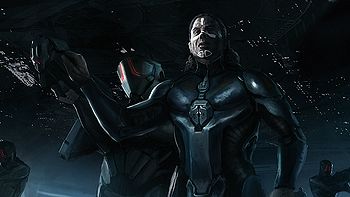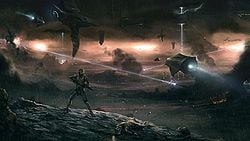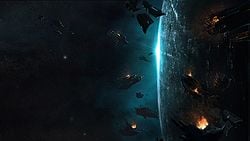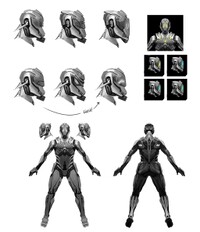Ancestors
From Halopedia, the Halo wiki

By approximately 150,000 BCE, humanity had achieved a considerable level of technological sophistication, achieving interstellar travel and colonizing planets along the Orion Arm of the Milky Way Galaxy becoming a major political and military power rivaling the Forerunners. This civilization allied with an earlier civilization of the San 'Shyuum species and later waged war against the Flood, only to later suffer a disastrous defeat against the Forerunners and be subsequently regressed back into hunter-gatherers and confined to their ancient homeworld.
History
Origin and rise
Having evolved and achieved civilization on Earth, originally known as "Erda" or "Erde-Tyrene",[1] humanity was still at this point composed of many species of the human genus. Around 150,000 BCE, humanity moved their civilization outward along the Orion Arm, possibly to flee Forerunner control.[2] Early in their history, before encountering the Forerunners, humanity underwent a series of technological dark ages, which left their populations scattered across many worlds and resulted in the loss of most of their records, including the knowledge of Earth being their original homeworld. It was not until thousands of years later when scientists led by Yprin Yprikushma traced humanity's origins to Earth.[1]
After recovering from their dark age, humanity made the former Precursor world Charum Hakkor their capital to be close to one of the greatest collections of Precursor structures.[3] Humanity also formed an alliance with the San 'Shyuum species in order to gain access to their advanced technology.[4] At their height, humanity's technological advancement, combined with their understanding of Precursor technology, nearly rivaled that of the Forerunners.[5] Over the course of their history, humanity also fought a number of small-scale conflicts against Forerunners.[1]
At one point, humanity encountered an ancient being, known as the Primordial, held in hibernation on a planet near the galaxy's edges. Under Yprin Yprikushma's orders, this being was placed in a stasis capsule and transported to Charum Hakkor for study.[1] Human researchers found a way to communicate with this entity, asking for answers to various scientific or metaphysical questions, but received no useful responses.[6] Instead, the being revealed disconcerting truths about human origins and the Flood; this was believed by some to have caused the demoralization of human culture and thus contributed to their defeat against the Forerunners.[1]
War
- Main articles: Human-Flood war, Human-Forerunner war

This civilization encountered the Flood in approximately 110,000 BCE, and after discovering the parasite's true nature, went to war against it. They also inquired the captive on Charum Hakkor about the Flood; the answers they received were so traumatizing that many committed suicide.[6] Eventually, humanity discovered a "cure" for the Flood: According to the Forerunners, they sacrificed a third of their total population, implanting them with destructive, artificially programmed genes used to target the Flood on a genetic level. In reality, however, the Flood had receded by its own volition after the sacrifice; no cure was ever created or used by humanity,[7] though both Forerunners and humans themselves remained under such illusion.[8]
After losing many planets to the Flood, humanity desperately invaded a minor sector of the Forerunners' ecumene. The Forerunners responded violently to this aggression and waged war with the humans and their San 'Shyuum allies. Stretched thin due to fighting two wars at once, the humans were finally driven to their capital Charum Hakkor. After holding off for fifty years, they were defeated at the hands of the Forerunners, led by the Didact.[9] Before the fall of Charum Hakkor, some humans suggested they should draw out the Flood and use it against the Forerunners. However, this strategy was denied, as the human leadership chose to face defeat rather than allowing the Flood to spread.[10]
Downfall
As punishment for defying the Forerunners, nearly all of humanity was wiped out and the remnants of their civilization and technology dismantled, while humans themselves were subjected to biological reduction.[11][12] The remnants of the human species were exiled to Earth, where they were overseen by the Librarian; while many Forerunners wanted to see humanity wiped out, the Librarian had always been considered their greatest protector.[13] With the assistance of the Librarian and a geas she had imprinted them with, over twenty of their ancient species made recovery and formed separate populations on Earth,[11] including the k'tamanush, b'ashamanush, hamanush and chamanush.[12] This meddling was noted to have considerably distorted Earth's natural fossil records.[11]
The Forerunner victory proved disastrous for the galaxy, as the humans destroyed all their research data and physical evidence concerning the Flood, including their supposed "cure." Bornstellar Makes Eternal Lasting speculated it may have been humanity's last act of revenge to leave the Forerunners unprepared to face the incoming threat that led to the firing of the Halo Array. The last human survivors on Charum Hakkor had their minds extracted and archived by the Forerunners in order to find the cure by scouring the humans' memories.[14]
Partial recovery

Forced to start again, the collective human genus tried in vain to reattain their former glory, with some human communities such as the civilization built around Earth's largest city Marontik establishing wooden cities and steam-powered waterborne vessels nearly nine thousand years later.[12][15] Most humans, however, lived in Tier 7 tribal communities, such as the one that was encountered by the Forerunners during the construction of the portal to the Ark in eastern Africa.[16]
After the activation of the Halo Array, the human civilization regressed once again, and would remain as Tier 7 hunter-gatherers for nearly a hundred millennia.
Rediscovery
For much of humanity's history prior to the mid-26th century, virtually all artifacts and records of this former civilization had been lost to time. However, in the mid 2550s, after the Human-Covenant War had ended, small but significant discoveries began to trickle in about humanity's powerful past. On Heian, ruins were found resembling a wide variety of human styles, including Greco-Roman, Middle Eastern and East Asian, with subtle Forerunner themes. The Department of Xenoarchaeological Studies at the University of Edinburgh found the obvious elements of human architecture in the structures puzzling, wondering if their builders borrowed from human architecture or the other way around.[17]
Records of prehistoric humanity began to be encountered as well. On Onyx, an artifact referred to as the "Bornstellar Relation" gave a testimony of the life of the Forerunner Bornstellar Makes Eternal Lasting, including the knowledge that humanity had once been a Tier 1 species.[18] This account was complimented by the testimony of the remains of 343 Guilty Spark, who related to listening scientists about his life as the prehistoric human Chakas.[19][20]
Then, in 2557, the SPARTAN-II John-117 encountered an archived personality of the Forerunner known as the Librarian on Requiem. She revealed the times of the ancient war to the soldier as well as the origins of the mechanical Prometheans; ancient humans that had been the first 'conscripts' into the Didact's army during the last years of the Forerunner's war against the Flood. The Librarian went on further to reveal that she had been guiding humanity since their devolution, notably their physical evolution, combat skin, and even AIs like Cortana in an attempt to prepare humanity from an unknown threat. John would later share this information to the rest of humanity (specifically the crew of the UNSC Infinity).[21]
Culture
Little is known about human culture of this time. It is known that humanity believed themselves to be the true inheritors of the Mantle, a notion the Forerunners considered heretical.[3] Ironically, the Precursors had actually intended humans to inherit the Mantle instead of the Forerunners.[22] Regardless of the pressure on their growing populations and the Flood, humans were also said to be particularly cruel toward other species. Chakas, examining the harvested memories of his ancestors imprinted to him as part of a geas, discovered that they believed in "creating many souls," or expanding their population by conquering and claiming other worlds.[23] They appear to have had a polytheistic religion, as suggested by the Lord of Admirals making a reference to "gods".[24]
The humans, along with their San 'Shyuum allies, favored the domesticated Pheru, originating from the planet Faun Hakkor, as pets. The Pheru would also be the first vectors for the Flood.[25]
Members of the ancient human military sported various kinds of white facial markings and typically had long hair. Warship crew members wore unadorned, mostly form-fitting suits of body armor, apparently lacking any markings or other features denoting rank,[26] although more elaborate uniforms existed, possibly for ceremonial occasions.[27]
Technology
Prior to the dismantling of their civilization, humanity had reached Tier 1 on the Forerunner technological achievement scale, making them nearly technological equals of the Forerunners. This was largely thanks to the efforts of Yprin Yprikushma, who encouraged humanity to study Forerunner technologies they had encountered in their early conflicts with Forerunners.[1] Despite this, humanity's understanding of slipspace technology, particularly in the area of causal reconciliation, was inferior to that of the Forerunners who were able to use their superior understanding of slipspace to an advantage by clogging the humans' slipspace channels and slowing down their interstellar travel.[28] However, the Didact indicated at one point, humanity with the help of the San 'Shyuum had developed offensive military technologies that Didact's warriors had no effective defense against and enabled them to compensate against the overwhelming numbers of the Forerunner military.[29]
It is known that humans of this time used artificial intelligence constructs.[1] On Charum Hakkor, the humans built vast constructs supported by the Precursor structures; cities stretching to orbit along orbital arches, described by Bornstellar Makes Eternal Lasting as resembling ivy growing on great trees. In addition, they built energy towers and defense platforms operating at geosynchronous orbit and equigravitation,[30] linked by virtually unbreakable Precursor unbending filaments.[31]
It is known that humanity and Forerunners infantry shared many similar military technologies, including advanced battle armor and energy-based weapons. Human warships were capable of high intensity energy streams capable of destroying large shielded Forerunner ships in single hits and also sterilizing entire flood infected worlds.[26]
Sphere of influence
Humanity's empire encompassed at least 20,000 worlds in a thousand star systems across the galaxy;[32] whether this is before or after they lost a third of their colonies to the Flood is unknown.
Notable individuals
- Forthencho - Lord of Admirals, head of the human Admiralty.[28] Commanded the last human fleets against the Didact's forces at Charum Hakkor.
- Yprin Yprikushma - Political and Morale Commander and prominent scientist. She contributed significantly to the technological breakthroughs that allowed humanity to hold off against Forerunners.
Trivia
The common term for the different human species, "manush", was derived from the Romani language, in which manush is the word for "human being" or "man". The word itself is one of many derivatives of the Sanskrit word manusia, among the Indo-Aryan languages.
List of appearances
- Halo: Cryptum (First appearance)
- Halo: Combat Evolved Anniversary
- Terminals (Mentioned only)
- Halo: Primordium
- Halo 4
Sources
- ^ a b c d e f g Halo: Primordium, page 237-238
- ^ Halo: Cryptum, page 20
- ^ a b Halo: Cryptum, page 112
- ^ Halo: Cryptum, page 113
- ^ Halo: Cryptum, page 164
- ^ a b Halo: Cryptum, page 271
- ^ Halo: Primordium, page 367
- ^ Halo: Primordium, page 53
- ^ Halo: Cryptum, page 267-272
- ^ Halo: Primordium, page 190
- ^ a b c Halo: Cryptum, page 127
- ^ a b c Halo: Cryptum, page 25
- ^ Halo: Cryptum, page 77
- ^ Halo: Primordium, page 234-235
- ^ Halo: Cryptum, page 86
- ^ Halo 3: The Cradle of Life
- ^ Halo: Evolutions - Essential Tales of the Halo Universe, From the Office of Dr. William Arthur Iqbal
- ^ Halo: Primordium, page 230
- ^ Eleventh Hour reports, part 4
- ^ Halo: Primordium, pages 376-379
- ^ Halo 4, campaign level Reclaimer
- ^ Halo: Primordium, page 364
- ^ Halo: Cryptum, page 130
- ^ Halo: Primordium, page 320
- ^ Halo: Cryptum, page 131
- ^ a b Halo 4, Terminals
- ^ Halo: Primordium, page 302
- ^ a b Halo: Primordium, page 240
- ^ Halo: Cryptum, page ??
- ^ Halo: Cryptum, page 164
- ^ Halo: Cryptum, page 118
- ^ Halo: Primordium, page 129



